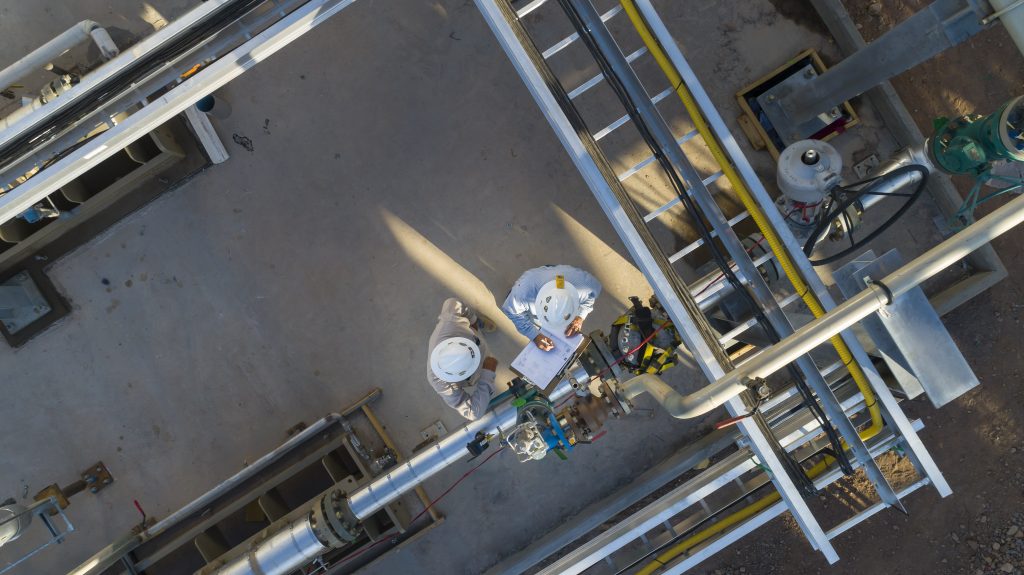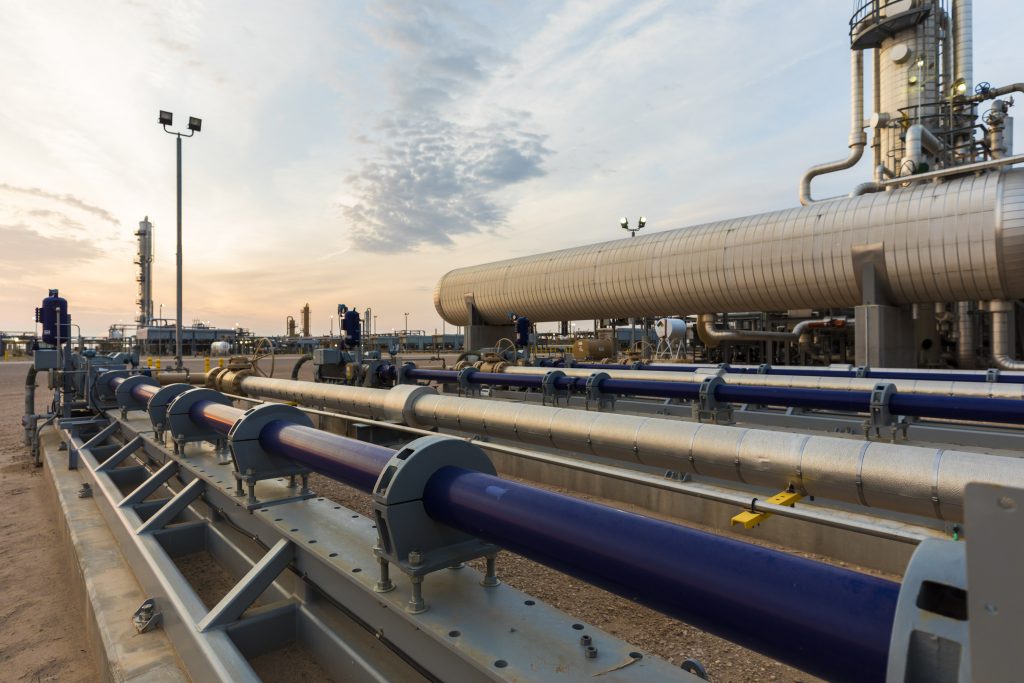Click here to listen to the Audio verison of this story!

“Timelines are getting pushed out, and people have to really think forward, and that’s really pushed the industry even more.” Saulsbury Industries’ Conway says that SI is working on projects for completion in 2026 and beyond.
Despite the Permian Basin being the second-biggest natural gas producing region in the United States, gas is a byproduct—and often a nuisance—here. But to keep the oil flowing, the gas must also flow, even when sales prices are negative. Fortunately, infrastructure keeps being built, and the famously negative prices at the Waha hub near Pecos only affect a few producers.
Construction for processing plants and infrastructure remains robust, says industry construction firm Saulsbury Industries. As the Permian’s shale plays continue to mature, the wells here become gassier, boosting gas production faster than oil output. That can create some challenges for takeaway capacity.
In April of this year, research firm Enverus Intelligence Research (EIR) released a report saying they expected prices at the Waha hub to go negative again this summer, like they did in 2024. Ironically, a few days after that report, prices dropped below zero, as if to prove EIR’s point. The report’s author, EIR advisor Jason Feit, provided additional insight for this story.
In theory, he said, there is exactly enough capacity for the current production levels, both of which are pegged at 21 billion cubic feet per day (Bcf/d). So everything’s fine, right?
Only on some days, said Feit. “Where it gets interesting is that 21 Bcf/d of takeaway capacity is when everything’s working great—and in the pipeline world, everything doesn’t work great every single day.”
He continued, “What we’ve seen in the last few months, which is what we see really every year, [is that] spring maintenance occurs. Pipelines are working on their facilities, and their ability to move gas actually declines during that time. Then you really see a tight market like we’ve had at Waha for quite some time.”
The good news is that Waha prices only affect a few producers, because most have long-term take-or-pay contracts with what’s called “wellhead-to-water” midstream companies. After recent rounds of merger and acquistions (M&A), there are fewer midstream companies, but those that remain want to control the molecules all the way from the wellhead to the processing plants or LNG export facilities on the Gulf Coast, Feit explained.
It’s not only natural gas, but also “ethane, propane, butane—those NGLs that get produced and then get exported to other countries such as Japan and China, Canada, Mexico, etcetera,” he said.
This plan includes most of the big midstream firms. “Whether it’s Targa, Phillips 66, Energy Transfer, ONEOK—all the big players, they’re quite active at every stage, including in the gathering and processing side of the Permian. and most of them have projects and development announced into the future for some time.” Producers contracted with these carriers are not subject to spot prices at Waha. Feit noted that Waha mainly involves small independents, who don’t have long-term contracts. He added, “I think for the most part, the larger players have their takeaway capacity locked down.”
What percentage of gas that amounts to is unknown, he said, because the vast majority of Permian natural gas stays on intrastate pipelines, which are not required to report their volumes, unlike interstate lines regulated by the Federal Energy Regulatory Commission (FERC).
Additionally, some natural gas is used at or near the wellhead to power production facilities, data centers, bitcoin mining, or other uses. Those also avoid Waha vagaries, and are impossible to quantify with any detail.
With the Matterhorn line having entered service earlier, there are three more lines under construction, with expected completion dates in 2026. They include:
The Gulf Coast Express expansion likely to come online Q2 2026. Its capacity will be around 570 Mcf/d.
The Blackcomb pipeline, also Q2 2026. Its capacity is 2-1/2 Bcf/d. Both of these will go to a hub near Agua Dulce, near the border with Mexico.
The Hugh Brinson, expected Q4 of 2026, headed to the Dallas area. Its capacity is currently listed at 1-1/2 Bcf/d, but could grow to 2.2 Bcf if the company sees enough support.
Even at this, Feit sees takeaway capacity maxing out by the end of the decade if more lines are not built, due to new drilling and the aforementioned increase in gassiness per well. He noted that several are in the consideration phase, but have not yet reached final investment decision (FID) status.
Saulsbury Moves Forward
Odessa’s Saulsbury Industries has built their main business around cryogenic plants for natural gas processing—and that is still their “bread and butter” according to Gary Conway, the company’s chief commercial officer—they have been working in some other markets as well. Conway was recently onboarded after many years with public and private midstream companies.
Like others, Saulsbury also is seeing the need for more natural gas processing and takeaway capacity and is already planning and working on projects looking into 2026 and beyond. On a cryogenic facility, for construction to be completed, “It takes anywhere from 14 to 18 months, potentially even longer, depending on the length of time and acquisition of the major parts,” Conway said. “So the timelines are getting pushed out, and people have to really think forward, and that’s really pushed the industry even more.”
After focusing on midstream gathering and cryogenic facilities for 30 years, Conway said the company is also doing projects including gas compressor stations and pipeline construction as well as adding utilities and renewables to their list. “We have a field services team and a utilities group as well that handles a lot of those small to mid-cap infrastructure-style projects.” He continued, “So we have a nice stream of projects that we’re working on today.”
Conway is encouraged by the Trump administration’s focus on freeing oil and gas projects from extreme regulations and delayed approval times. “We’ve been able to continue to move forward and I think we, as an industry, see that we can actually build large infrastructure in a little bit faster way. That includes long haul pipelines and getting that infrastructure in place to help meet that demand here at home and be able to export.” For Saulsbury, the progress includes increased business opportunities elsewhere, including in the Haynesville formation of East Texas and northern Louisiana as well as in the Permian.
Data Centers
Using locally produced natural gas to generate power for data centers is a great idea, Conway says, but a data center’s power demands are bigger than a single well can supply. “Consider this: the amount of gas that it takes to power them is probably 250 to 300 MW. That’s the first tranche of power, and it can’t be done by one well. The power demand challenge for the data centers will require 5-10 Bcf/d of gas, according to various prognostications. It has to be done off transmission pipelines. It is a major pull.” That fact will require data centers to be near gas transmission lines or large supply pools.
Another thing pushing data centers beyond just one well is the fact that they need high quality reliable gas supply for the generation of power—something that can only come from pipelines carrying processed gas with nitrogen and other contaminants removed.

Cryogenic plants for natural gas processing has been, and remains, Saulsbury Industries’ “bread-and-butter” as general contractors in the Permian Basin.
Company Culture
It’s great to have work, but many companies are struggling to find good people to do it. Conway says one thing that’s impressed him about Saulsbury is its commitment to safety and to people as a whole.
“If you build your company on a culture of integrity and service and safety and respect, it becomes not only an introverted way of business but extroverted as well in how you deal with your customers. I think Saulsbury continues to get business because of how they approach the business. They continue to keep good quality people because of how they approach the business. So both from an introverted and extroverted look, that culture goes both ways,” he said.
What’s the Takeaway?
With any raw material, getting it out of the ground matters only if it then has some way to get to market. As the current administration has promised to speed permitting of a wide variety of energy infrastructure buildouts, the natural gas sector has hope that the continuing leapfrogging of production with takeaway capacity will smooth out as more midstream comes online.
With the rise of data centers and gas-fired power generation to fuel the electrification of industry and transportation, the demand certainly seems secure at least for the next several decades.
Paul Wiseman is a longtime writer in the energy sector.












